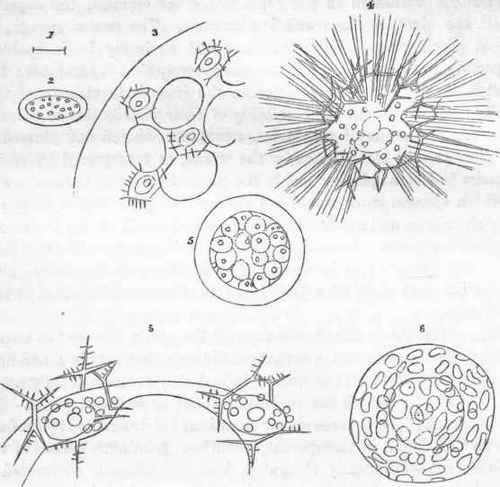Protozoa. Part 11
Description
This section is from the book "General Outline Of The Organization Of The Animal Kingdom, And Manual Of Comparative Anatomy", by Thomas Rymer Jones. Also available from Amazon: A General Outline of the Animal Kingdom and Manual of Comparative Anatomy.
Protozoa. Part 11

Fig. 13. This figure represents the several stages of evolution of the Spermatozoa in the common creeper (Certkia familiaris), magnified about a thousand diameters. I, an adult Spermatozoon, taken from the orifice of the vas deferens; a, b, c, seminal granules, which are probably nothing more than altered epithelial cells; d, e, f, cysts or vesicles enclosing one or more round granular globules; g, a similar cyst containing, besides the two globules, a finely-granular mass, in which the Spermatozoa may be seen to form; h, the cyst, still containing finely-granular matter, has assumed an oval form, and the bundle of spermatic animalcules, increased in size, lies bent up within it; i, a cyst still more developed; the involucrum, pear-shaped, covers the bundle of animalcules where their spiral extremities lie; k, a cyst arrived at maturity, still covered by the involucrum. (After Wagner).
1 Vide Leuwenhoeck, vol. iv. pp. 268,284: Ehrenberg, Infusionsthierchen, p. 465: Valentin, Nov. Act. Acad. Leopold, vol. xix. p. 239.
* Professor Grant.
1 Vide Von Siebold, in Midler's Archiv, 1836 and 1837: E.Wagner, Fragmente zur Physiologie der Zeugung; Beitriige zur Greschichte der Zeugung und Entwicke-lung, in den Abhandlung. der Konigl. Bayerisch. Akad., Munich, 1837: Kolliker, Beitriige zur Kenntniss der Geschlectsverhaltnisse und Samenflussigkeit wirbellosen Thiere, Berlin, 1841; Die Bildung der Samenfaden in Blaschen, Nuremberg, 1846.
(62). Very widely distributed through the ocean, whether in tropical or extra-tropical climates, peculiar gelatinous bodies may be found floating upon the surface of the water; indeed they are occasionally among the most constant of all the various products of the towing-net. The THALASSICOLLA*(for so these simple organisms are designated by Professor Huxley1 ) is found in transparent, colourless, gelatinous masses of very various form - elliptically elongated, hourglass-shaped, contracted in several places, or spherical, varying in size from an inch in length downwards, - showing no evidence of contractility nor any power of locomotion, but floating passively on the surface of the water. Of such bodies there appear to be two very distinct kinds. In one, the mass consists of a thick gelatinous crust containing a large cavity. The crust is structureless; but towards its inner surface minute spherical, spheroidal, or oval bodies are imbedded (fig. 14, 2), each of which appears to be a cell with a thin but dense membrane, and containing a clear fatty-looking nucleus surrounded by granules, - the whole substance, in fact, resembling an animal Palmella. Very commonly the central part of each mass, instead of containing a single large cavity, consists of an aggregation of clear, closely appressed spaces resembling vacuoles (fig. 14, 3); and frequently each cell is surrounded by a zone of peculiar crystals, somewhat like the stellate spicula of a sponge, consisting of short cylinders, from each end of which three or four conical spines radiate, each of these again bearing small lateral processes (fig. 14, 4 & 5.) Frequently the connecting substance in which the cells are imbedded appears to be quite structureless; but in some specimens delicate, branching, minutely granular fibrils may be seen radiating from each cell into the connecting substance (fig. 14, 4).
The sea.
Glue.
1 Vide Ann. and Mag. of Nat. Hist. ser. 2. vol. viii. p. 433.

Fig. 14. Structure of Thalassicolla (after Professor Huxley).
In the second form of Thalassicolla, the creature consists of a spherical mass of jelly, as large as the middle-sized specimens of the last variety, with an irregular blackish central mass. Enveloping this, and forming a zone about half the diameter of the sphere, are seen numerous clear spaces (vacuoles), and among these are scattered numerous yellow cells and a multitude of very dark granules. Delicate, flattened, branching fibrils radiate from the innermost layer, passing between the vacuoles; and in one specimen Professor Huxley observed these fibrils thickly beset with minute dark molecules which were in active motion, as if circulating along the fibrils, but without any definite direction.
Continue to:


